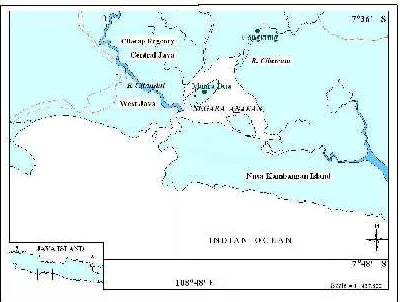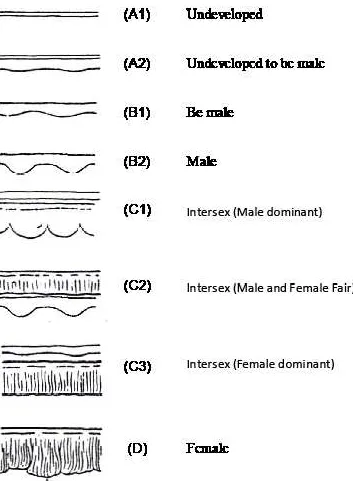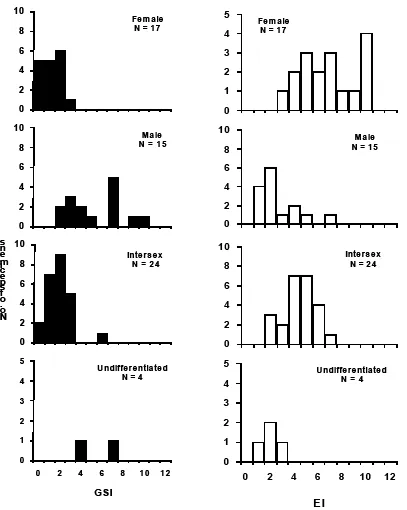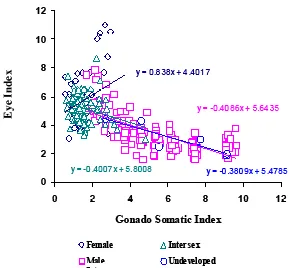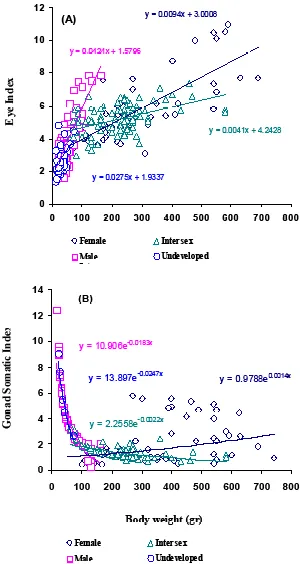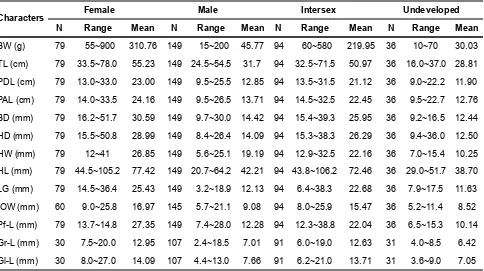SEXUAL DEVELOPMENT OF THE TROPICAL SHORT-FINNED EEL Anguilla bicolor bicolor OF THE SEGARA ANAKAN WATERS, CENTRAL JAVA, INDONESIA
Hagi Y. Sugeha*)♠ ), Irwan Jatmiko**), Sahri Muhammad*)
*) Research center for Oceanography-LIPI, Jakarta **)Agency of Marine and Fisheries Research-DKP, Jakarta ***) Faculty of Fisheries and Marine Science-Brawijaya University, Malang
♠) Corresponding author, e-mail: hagi001@lipi.go.id
Abstract
A total of 289 specimens of tropical short-fi nned ell (Anguilla bicolor bicolor) was collected from Segara Anakan in May, September, October and November 2004. Basic biological information including body weight (BW) and total length (TL), gonad morphology, gonad somatic index (GSI) and eye index (EI) among collecting specimens were examined in order to understand their sexual development. It was found that Anguilla bicolor bicolor from Segara Anakan were greatly varied in body weight (10-900 g) and total length (19-78 cm), suggested their occurred in different like stages (young to adult ell). Based on gonad morphology it was found that sexual development of the species could be separated into four groups namely: female (17.6%), male (48.1%), intersex (32.2%) and developed (2.1%). GSI were 0-3 in female, 1-9 in male, 0-4 in intersex and 2-7 in undeveloped. EI were 3-10 in female, 1-7 in male, 2-8 in intersex and 1-4 in undeveloped. Positive relationship was found between EI and BW and TL of the species in each sexual development, but no correlation between GSI and BW and TL, except for female. Different from temperate eels that bigger in GSI and EI, suggested earlier sexual maturation in the tropical in the temperate.
Key words: Anguilla bicolor bicolor, EI, GSI, Segara Anakan, Sexual development
Introduction
The freshwater eels of genus A nguilla Schrank, 1798, were widely distributed in the world. From a phys iological viewpoint the eel is a particularly popular for an experimental animal. This due to not only to its extremely marked resistance to many short of experimental condition, but also to the large number of unusual characteristic of distinguish the eel from other species of fi sh. Included among these characteristics are their phases of differential activity and behavioral patterns, its multistage metamorphosis during ontogenic development, its great endurance and its ability to navigate during migration also its unusual body shapes . T he freshwater eels have several groups of species that have very similar morphological features (Watenabe, 2001). However, in some species of temperate eels, the morphological characters were used as secondary characters on study the reproductive characters of its anguillid eels.
In most fishes, male and female are separates individually, however, this tipical reproductive of live history strategy in open to many modifi cation. Some species have internal fertilization, but some are hermaphrodite or change sex during their life time like occur in eel. The newly hatched of young eel are a
few mm long, usually in the form of larvae quite unlike the adult, with the yolk sac and relatively undeveloped body form. Once the yolk sac is reabsorbed, the larvae must fi nd foods on its own. After a period of growth, the larvae metamorphose into juvenile, immature adult and mature form. The earliest stage it is possible to distinguish male from female gonads macroscopically when the fi sh reach length of about 20 cm (Walter, 1910 in Tesch, 1979) although according to some authors, identifi cation cannot be made until reach a length of 30 cm (Satoh et al., 1965; Sinha & Jones, 1966).
The gonad is mesodermal in origin and develops in close association with the nephric system. As teleost, the paired gonads of eel derived from single region equivalent to the cortex. The location and determination of the gonads as male or female is often diffi cult in immature specimens when fatty tissues sometimes make miss identified as gonad. The gonad are equal size, when the right extending further forward about 1 cm in 30 cm European eels and the left reaching further posteriorly (about 2 cm behind the cloacae in 30 cm) also in European eels (Tesch, 1979). The left gonad is about 2-3% longer (Tesch, 1979) and is heavier and contain more eggs then the right gonad (Matsui, 1979). Kochencko (1959) in
Tesch (1979) related head with ovarian width when broad-headed specimens had gonad about 5-6 mm across while eel with more pointed head has ovaries about 9 mm wide (Tesch, 1979).
Those studies has been mainly conducted in the temperate eels, however, almost no study has been done in the tropical eels. Therefore, we propose to study on the sexual development of short-fi nned eel (Anguilla bicolor bicolor) as one of the representative tropical eels that inhibit in the Indonesian Waters. The objective of this research was to know the sexual development of a Anguilla bicolor bicolor from Segara Anakan (Central Java, Indonesia) based on body measurements and gonad observation.
Material and Method
Eel samples were collected in the Waters of Segara Anakan (Central Java, Indonesia) (Fig. 1) in May, Se pte mber, October and Nov emb er 2 004 . In order to get representative sample, by conducting collaboration with local fi sherman, the live specimen of yellow and silver eel in various size and number were collected using several fi shing gears including line and bait, trap and fi sh net. The eels were kept alive after captured and transported to the laboratory for further examination.
Before morphological data collection of the body shap es, the specimens we re o ver dosed with anesthesia. After weighting the body weight (g), the body length (cm) measurements were done including total length (TL), pre-dorsal length (PDL), pre-anal length (PAL), body depth (BD), head length (HL), head width (HW), head depth (HD), inter-orbital width (IOW) and pectoral fi n length (Pf-L) to the nearest 1 mm. The morphological characters of ano-dorsal length (ADL)/%TL (Sugeha, et al., 2001; Watanabe, 2001) and the dentition structure (Watanabe, 2001) were used as fi rst confi rmation for species identifi cation. Thereafter, specimens were dissected to pick up a piece of liver tissue for crossing check with genetic species identification using PCR-RFLP analyses (Sugeha et al, 2006; Sugeha et al, 2008, in press). Gonad morphology and development were observed and described based on Satoh et al (1962). Afterthan gonads were measured including gonad length (GL) and gonad width (GW) in both left and right side. After measurement, gonad were removed and weighed for adjustment the GSI of the specimen. The Gonad Somatic Index (GSI) was calculated as:
Gonad Somatic Index = (gonad weight/body weight)x100
The eye index (EI) was also calculated as: Eye Index = {((A+B)/4)2 *π/L}*100
(Pankhurst, 1982a)
Where A is the horizontal eye diameter, B is the vertical eye diameter and L is the total length.
Result
S pe cim en co lle ctio n , spe cie s/sub sp e cie s adjustment
A total of 289 specimens of tropical short-fi nned eels were collected from the Waters of Segara Anakan and were used for this study. Based on morphology and genetic analysis, all the specimens identifi ed as Anguilla bicolor bicolor. Using external morphology character (ano-dorsal length as percent of total length) the range of ADL/%TL of the species about -3 to 4 and using internal morphology character (number of ano-dorsal vertebrae) the range of ADV of the species about -3 to 3. Using six restriction enzymes (Alu I, EcoT14 I, BbrP I, Hha I, Mva I, and Bsp1286 I) as the specifi c enzymes to recognized the tropical eel species, the result performed 6 haplotypes of A. bicolor bicolor inhabit in the Indonesian waters (Sugeha et al, 2006; Sugeha et al, 2008). Additional morphology characters (broad maxillary band of the teeth structure and non-variegated marking of the skin type) also suggest that the specimens used in this study was A. bicolor bicolor only.
External morphology characters
Based on body skin coloration, all specimens of A. bicolor bicolor collected from the Waters of Segara Anakan might belong to silver eel stage (25%) and yellow eel stage (75%). The silver eel was dark in dorsolateral portion and the belly pectoral fi n were dark black with a golden color at the base. The yellow eel was brown yellowish in dorsolateral portion, pectoral fi n were yellow brownish with a white color at the base.
Anguilla bicolor bicolor from Segara Anakan were greatly varied in body weight (BW=10-900gr) were the female about 55-900 g, the male about 15-200 g, the intersex about 60-580 g, and the undeveloped about 10-70 g. The average of body weight was 310.76 g in female, 45.77 g in male, 219.95 g in intersex, and 30.3 g in undeveloped. Based on body weight measurements, it was found that female and intersex A. bicolor bicolor was heavier than male, but male was heavier than undeveloped.
The total specimen of A. bicolor bicolor was also varied from 16.0-78 cm in TL. The range of TL was 33.5-77.8 cm, 24.5-54.5 cm, 32.5-71.5 cm, and 16.0-37.0 cm in female, male, intersex, and undeveloped, respectively. The average of TL was 55.23 cm, 31.70 cm, 50.97 cm, and 28.81 cm in female, male, intersex, and undeveloped, respectively. The results suggested that female and intersex was longer than male, but male was longer than undeveloped.
Inter orbital width (IOW) is usually greater in males than in females in the temperate eels, however, in the present study we found that IOW of female A. bicolor bicolor (16.97 cm) was greater than male (9.08 cm). It is suggested that external morphological characters of IOW was different between species, so that the characters of temperate eels species could not be used as guidance for the same characters in tropical eel species. Head length (HL) as the distance from the tip of the snout to the insertion of the pectoral fi n was reported to be greater in female than in males, in temperate eels. In the present study we found that HL female A. bicolor bicolor was 44.5-105.2 cm, male was 20.7-62.2 cm, intersex was 43.8-106.2 cm, and undeveloped was 29.0-51.7 cm with an average of 77.42 cm, 42.21 cm, 72.46 cm, and 38.70 cm in female, male, intersex, and undeveloped, respectively. It means, similar with temperate eels, tropical eels of A. bicolor bicolor also greater than male in the character of head length. However, it was also found that intersex also greater than male in HL, but male was greater in HL than undeveloped.
The character of pre-dorsal length (PDL= the distance from the tip of the snout to the dorsal fi n origin) was found to be greater in female than in male of the temperate eels. In the present study, it was also found that the PDL of A. bicolor bicolor was greater in female (23.00 cm) than male (12.85 cm), intersex (21.12 cm), and undeveloped (11.90 cm).
In general, it could be seen in the Table 1, that all character of external morphology of A. bicolor bicolor was greater in female compared to male, intersex, and
undeveloped eels. However, external morphological characters of intersex eels were greater than male eels, and external morphological characters of male eels were bigger than undeveloped eels.
Gonad morphology and sexual determination Based on gonad morphological observation, it was observed that gonad of A. bicolor bicolor performed “curtain like shape” and that were recognized as the texture of female gonad while gonad performed “split like shape” were recognized as the texture of male gonad (Fig. 2). Both sexual development have milky color and softly texture on gonad tissue. Gonad intersex more transparent with jelly textured. In the present study, gonad intersex of A. bicolor bicolor were separated in three character: C1 (gonad texture dominant male), C2 (female and male gonad mixed), and C3 (gonad texture dominant female). Gonad undeveloped was combination between transparent and milky tissue with more jelly texture. The undeveloped gonad was separated in two characters: A1 (the appearance of two straight lines of gonad tissue), and A2 (the appearance of two straight lines of gonad tissue, but the other one with more advance development to perform “split like shape”) that may have tendency to be male gonad texture. Gonado Somatic Index and Eye Index
Gonad somatic index (GSI) of all collecting specimen was examined in order to understand their sexual development. Female silver eel A. bicolor bicolor that collected in the present study has relatively smaller ovaries compared to male silver eels. Gonado Somatic Index were 0-3 in female, 1-9 in male, 0-4 in intersex, and 2-7 in undeveloped. Further, male A. bicolor bicolor was more dominant and more mature than female in the Waters of Segara Anakan. Intersex characters mostly observed in yellow eel stage with GSI 0-4 while undifferentiated mostly observed in silver eel stage with GSI (5-7) than in yellow eel stage (2-4) (Fig. 3).
eel (2-7) was almost similar with GSI male eel so they might be in both sexual immature and mature eel. Length of gonad left (Gl-L) proposed to be greater than length of gonad right (Gr-L), in the temperate eel. In the present study, it was found that Gl-L was greater than Gr-L in female, intersex, and undeveloped. However in male, Gl-L was similar with Gr-L. Ey e inde x (E I) of all collecting sp ecimen was ex amined in order to u nderstand the ir sex ual development. Eye Index (EI) were 3-10 in female, 1-7 in male, 2-8 in intersex, and 1-4 in undeveloped. The result supporting the ideas above that female, male, and intersex in the present study was belong to sexual immature (EI≤6.5) and sexual mature (EI≥6.5), except for undeveloped eels that only belong to sexual immature stage with EI less than 6.5 (Fig. 3). Positive relationship was found between GSI and EI of female A. bicolor bicolor (y=0.838x+4.4017), but negative correlation was found between GSI and EI of male (y= - 0.4086x+5.6435), intersex 0.4007x+5.8008), and undeveloped eels (y=-0.38089x+ 5.4785) (Fig. 4).
Positive relat ionship was found between bo dy we igh t an d E I of A . b ico lor bico lo r fem ale (y=0.0094x+ 3.0008), male (y=0.0424x+1.5796), intersex (y=0.0041x+4.2428), and undeveloped (y=0.0275x+1.9337) (Fig. 5a). Positive correlation also found between body weight and GSI in female (y=0.9788e-0.0014x), but negative correlation was found
in male (y=10.906e-0.0183x), intersex (y=2.2558e-0.0022x),
and undeveloped eels (y=13.897e-0.0247x) (Fig. 5 b).
Positive relationship was found between total length and EI of A. bicolor bicolor female (y=0.1573x-2.8925), male (y=0.2425-4.2466), intersex (y=0.0493x+2.6372), and undeveloped (y=0.1303x-1.1022) (Fig. 6a). Positive correlation also found between total length and GSI of A. bicolor bicolor female (Y= 0.4233e -0.023x), but negative correlation was found in male
(Y=183.43e-0.1158x), intersex (Y=6.7004e-0.0307x), and
undeveloped (Y=164.87e-0.1113x) (Fig. 6 b).
Discussion
The sex uality of teleos t fishes is extraordinary complex. Hermaphroditism is almost unknown in the freshwater group but it is common in marine fi shes. Hermaphroditism may be successive where the individual starting as a male and becoming a female or synchronous where both parts of the ovitestis mature together (Bone et al., 1999). In the
succsesive hermaphroditism, the males are obviously smaller than the females (Krueger et al., 1997). Size is much more at premium for the females so that they can accomodate a large number of eggs. The male, having fertilized the eggs of its older and larger conspecifi cs, can than be saved to become a female itself. In anguillid eel, the hermaphrodite are protandrynous where the individuals change from males to females.
The tropical eel, A. bicolor bicolor, belong to short-fi nned and non-variegated marking eel (plain eel), so that easy to separated external morphologically from the other species of the genus with naked eye. However, the species ecologically diffi cult to found in the upstream region or even in the river and lake. The species have tendency to living in the lower land or lower limit of freshwater area, especially in the brackishwater area, estuary, or mangrove area. However, other species of tropical eel (A. marmorata, A. celebesensis, A. interioris, and A. borneensis) has been reported to inhabit up to the river till the lake (Sugeha et al., 2001; Sugeha, 2003; Sugeha et al., 2006; Sugeha et al., 2008). There was no detail study has ever been done to clarifi ed the phenomenon of species zonation in the tropical eel since the organism is quit diffi cult to collect in the fi eld, but it was done in temperate eels (Krueger and Oliveira, 1999). However, from this study could be clarifi ed that the short-fi nned eel A. bicolor bicolor were inhabit in the lower area of freshwater ecosystem of the Segara Anakan Waters.
In the present study the species could be found in various lige stages including glass eel, elver, yellow eel and silver eel, and suggested that they may living on that area and not migrate up to the river side until they are ready to back to the ocean for spawning. Such specifi c living bahaviour might become important adaption of the species for survive and compete with the others species of tropical eels. The body size of A. bicolor bicolor is relatively smaller than the other species of tropical eel, so they may loose for food and space when they tried to migrate upstream as the others species of the genus. ”Choice” for staying in the lower part of the river were support A. bicolor bicolor to life in savety and also allow the species to keep energy for long journey spawning migration from the estuary to the ocean and not from the lake to the ocean like the other species (Jessop, 1987; Oliveira et al., 2001; Sasai et al., 2001).
data, and none can therefore be considered suitable as a ready means for distinguishing individual male and female on external features alone. There are nevertheles s, ex perience d worked who, u sing these parameters, are almost always successful in separating males from females, even in the European eel (Durif et al., 2006; Pankhurst, 1982; Proman and Reynolds, 2000). Until the eels are at least 20 cm long, male are still largely undifferentiated externally (Tesch, 1979). But here in the present study, we found that undeveloped eel may reach until 37 cm long, while positive male may reach 54.5 cm long. Overlapping total length was occured from 24.5 cm to 37 cm between male and undeveloped, and could be suggested that most of the undeveloped eel would become male and not female. In contrast, total length of female and intersex was quiet overlapped (33.5 cm to 71.5 cm), so undeveloped eel has a tendency become a female. If this is true than it could be proposed that related to body size, tropical eel is the same with temparate eel were males was smaller than females (Oliviera, 1998).
Different from temperate eels that bigger in size but smaller in GSI and EI, tropical eel A. bicolor bicolor was smaller in size but bigger in GSI and EI, it may be suggested more earlier sexual maturation in the tropic than in the temperate. However, advance in sexual maturation could not be adjusted from external morphological observation alone. Histological study were required to confi rm those ideas so the maturation stage including gonad maturation stage as well as oogenesis and spermatogenesis stage of the species could be carried out (Aida et al, 2003). Furthermore, study on the age of the species in each sexual development were important (Helfman et al., 1987; Holmgren and Mosegaard, 1996; Homlgren et al., 1997; Jellyman, 2001; Svedang et al., 1996; Tzeng et al., 2000) in order to adjust weather the differences of GSI and EI indicating the tropical eel was the same age, younger, or older than temperate eels. If oldest than temperate eels, it means highest growth rate was occurred in the tropical eel, so maximum body size was not the important role to be mature in the tropic. Different life history traits might be occurred between species (Oliviera and McCleave, 2000), but most seemingly that tropical eel have to perform highly growth rate compared to temperate eel (Sugeha, 2003). Fast growing phase were triggering fast sexual development in the tropical eel species and might be resulting on the multiple spawning ground and season through the year as proposed by previous authors
that possible to occurrs in the tropical anguillid eels (Arai et al., 1999; Sugeha et al., 2001; Sugeha, 2003; Aoyama et al., 2003).
Most study on sexual development of marine fi shes were based on histological analyses that required more tehcnique, time, and budget. This study is the fi rst study to examine sexual development of tropical eel based on combination between external morphology and gonad morphology analyses. The result shown important basic information on the sexual characters of tropical eel that may lead advance study in reproductive histological character of tropical eel including oogenesis and spermatogenesis studies of the species in the future.
Conclution
The growth rate of the tropical eel was higher than temperate. Tropical eel was smaller in size but bigger in GSI and EI. They have got earlier sexual maturation in the tropic than in the temperate zone
Acknowledgement
We wish to send our grateful to the local fi sherman and local people in the Waters of Segara Anakan for useful collaboration during the fi eld research. This study was supported by a research grant from the Program Competitive-LIPI, Sub Program Census of Marine Life in 2004 of fi scal year.
References
Aida K, K. Tsukamoto & K. Yamauchi. 2003. Eel Biology. Springer. 497p.
Aoyama J, Wouthuyzen S, Miller MJ, Inagaki T, & Tsukamoto K. 2003. Short-distance spawning migration of tropical freshwater eels. Biological Bulletin 204:104-108
Arai, T. 2000 . Ec ological study on the inshore migration of the eels, Anguilla spp. In Sulawesi Island. Ph.D thesis, The University of Tokyo Bone Q, N.B Marshall, J.H.S Blaxter. 1999. Biology
of Fishes. Tertiary Level Biology. Sec Ed. Stanley Thornes (Publishers Ltd). 332p.
Helfman G.S, D.E Facey, L.S Hales & E.L. Bozeman. 1987. Reproductive Ecology of the American Eel. Am Fish Soc Sym, 1:42-56
Holmgren K & H Mosegaard. 1996. Implications of individual growth status on the future sex of the European eel. J Fish Biol, 49:910-925
Holmgren K, H. Wickstrom & P. Clevestam. 1997. Sex-related growth of European eel, Anguilla anguilla, with focus on median silver eel age. Can J Fish Auat Sci, 54:2775-2781
Jellyman D.J. 2001. The infl uence of growth rate on the size of migrating female eel in Lake Ellesmere, New Zealand. J Fish Biol, 58:725-736
Jessop B.M. 1987. Migrating American Eels in Nova Scotia. Trans Ame Fish Soc, 116:161-170 Krueger W.H & K. Oliveira. 1997. Sex, size, and gonad
morphology of silver American Eels Anguilla rostrata. Copeia, 2:415-420
Krueger W.H & K. Oliveira. 1999. E vidance for environmental sex determination in the American eel, Anguilla rostrata. Environ Biol Fish, 55:381-389
Matsui I. 1952. Studies on the morphology, ecology and pondculture of the Japanese Eel (Anguilla japonica Temminck u Schlegel). J Shimonoseki Coll Fish 2 (2): 1-245
Oliveira K. 1998. Life history charcateristics and strategies of the American eel, Anguilla rostrata. Can J Fis Aquat Sci, 56:795-802
Oliveira K & J.D. McCleave. 2000. Variat ion in population and life history traits of the American eel, Anguilla rostrata, in four rivers in Maine. Environ Biol Fish, 59:141-151., 21:127-140 Oliveira K, J.D McCleave & G.S Wippelhauser. 2001.
Regional variation and the effect of lake: river area on sex distribution of American eels. J Fish Biol, 58:943-952
Pankhurst N.W. 1982. Relation of visual changes to the onset of sexual maturation in the European eel Anguilla anguilla (L.). J Fish Biol
Proman J.M & J.D Reynolds. 2000. Differences in head shape of the European eel, Anguilla anguilla (L.). Fish Manag and Ecol, 7:349-354.
Su geha H.Y, A rai T, Miller M.J, L imb ong D & Tsukamoto K. 2001b. Inshore migration of the tropical eels Anguilla spp recruiting to the Poigar River estuary on north Sulawesi Island. Mar Ecol Prog Ser 182:283-293
Sugeha H.Y. 2003. Life history of the tropical eel Anguilla marmorata (Quoy & Gaimard) in the Indonesian Waters.
Sugeha H.Y, Rochmadini & Sulandari S. 2006. Morphology and genetic characters of the tropical anguillid eel in the Indonesian Waters. Proc Nat Con Ichthyol, Jatiluhur (Indonesia), June 2006 S ug e ha H.Y, Su h ar ti S , Wo ut h u yzen S , &
Sumadhiharga O.K. 2008. Biodiversity, distribution and abundance of the tropical anguillid eels in the Indonesian Waters. Mar Res Ind (In press) Sasai S, J. Aoyama, S. Watanabe, T. Kaneko, M.J.
Miller & K. Tsukamoto. 2001. Occurrence of migrating silver eels Anguilla japonica in the East China Sea. Mar Ecol Prog Ser, 212:305-310 Satoh H, Nakamura N, & Hibiya T. 1965. Studies
on the sexual maturation of the eel. I On the sex differentiation and the maturing process of the gonads. Bull. Japan Soc Scient Fish, 28:579-584
Sinha, V.R.P. & Jones J.W. 1966. On the sex and distribution o f the fre shwate r eel (Ang uilla anguilla). J Zool London, 150:371-385
Sv edang H.E, Neuman & H. Wickstrom. 1996. Maturation pattern in female European eel:age and size at silver eel stage. J Fish Biol, 48:342-351
Tesch F.W. 1977. The Eel. Biology and Management of Anguillid Eels. London, Chapman and Hall. 434p.
Tzeng W.N, H.R. Lin, C.H. Wang & S.N. Xu. 2000. Differences in size and growth rates of male and female migrating Japanese eels in Pearl River, China. J Fish Biol, 57:1245-1253
Table 1. Morphology characters of Anguilla bicolor bicolor in each sexual development
Characters Female Male Intersex Undeveloped
N Range Mean N Range Mean N Range Mean N Range Mean
